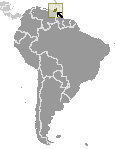World Atlas: Trinidad and Tobago. On this page you can see the map, country flag and many detailed information about the people, history and economy of Trinidad and Tobago.

Here you can find online selected information about the geography, inhabitants, government, economy and history of Trinidad and Tobago. Included are selected statistics, an overview map and the detailed map of Trinidad and Tobago. But let's start with the flag of Trinidad and Tobago here:
Trinidad and Tobago - Overview:
What you should know about Trinidad and Tobago? Let's start with this: First colonized by the Spanish, the islands came under British control in the early 19th century. The islands' sugar industry was hurt by the emancipation of the slaves in 1834. Manpower was replaced with the importation of contract laborers from India between 1845 and 1917, which boosted sugar production as well as the cocoa industry. The discovery of oil on Trinidad in 1910 added another important export. Independence was attained in 1962. The country is one of the most prosperous in the Caribbean thanks largely to petroleum and natural gas production and processing. Tourism, mostly in Tobago, is targeted for expansion and is growing. The government is coping with a rise in violent crime.
Geography of Trinidad and Tobago
 Where on the globe is Trinidad and Tobago? The location of this country is Caribbean, islands between the Caribbean Sea and the North Atlantic Ocean, northeast of Venezuela. Total area of Trinidad and Tobago is 5,128 sq km, of which 5,128 sq km is land. So this is quite a small country. How could we describe the terrain of the country? This way: mostly plains with some hills and low mountains. The lowest point of Trinidad and Tobago is Caribbean Sea 0 m, the highest point El Cerro del Aripo 940 m. And the climate is tropical; rainy season (June to December).
Where on the globe is Trinidad and Tobago? The location of this country is Caribbean, islands between the Caribbean Sea and the North Atlantic Ocean, northeast of Venezuela. Total area of Trinidad and Tobago is 5,128 sq km, of which 5,128 sq km is land. So this is quite a small country. How could we describe the terrain of the country? This way: mostly plains with some hills and low mountains. The lowest point of Trinidad and Tobago is Caribbean Sea 0 m, the highest point El Cerro del Aripo 940 m. And the climate is tropical; rainy season (June to December).
Inhabitants of Trinidad and Tobago
Let's take a look how many people live in Trinidad and Tobago. The number is: 1,218,208 (July 2017 est.). So not so many people live here. Who lives here? East Indian 35.4%, African 34.2%, mixed - other 15.3%, mixed African/East Indian 7.7%, other 1.3%, unspecified 6.2% (2011 est.). What are the languages in Trinidad and Tobago? English (official), Trinidadian Creole English, Tobagonian Creole English, Caribbean Hindustani (a dialect of Hindi), Trinidadian Creole French, Spanish, Chinese. And the religions: Protestant 32.1% (Pentecostal/Evangelical/Full Gospel 12%, Baptist 6.9%, Anglican 5.7%, Seventh-Day Adventist 4.1%, Presbyterian/Congretational 2.5%, other Protestant 0.9%), Roman Catholic 21.6%, Hindu 18.2%, Muslim 5%, Jehovah's Witness 1.5%, other 8.4%, none 2.2%, unspecified 11.1% (2011 est.). How old are the people in average? 36 years. We have to add that this number is the median - so one half of the people is older than this, one half is younger. And what is their life expectancy (at birth)? This: 73.1 years. Where the people live in Trinidad and Tobago? Here: population on Trinidad is concentrated in the western half of the island, on Tobago in the southern half. The major urban areas of Trinidad and Tobago are: PORT-OF-Spain (capital) 34,000 (2014).
Government and Economy of Trinidad and Tobago
The capital of Trinidad and Tobago is Port of Spain and the government type parliamentary republic. Let's take a look at the administrative divisions - 9 regions, 3 boroughs, 2 cities, 1 ward. Regarding the economy of Trinidad and Tobago, important industrial products are petroleum and petroleum products, liquefied natural gas, methanol, ammonia, urea, steel products, beverages, food processing, cement, cotton textiles. Important agricultural products are cocoa, dasheen, pumpkin, cassava, tomatoes, cucumbers, eggplant, hot pepper, pommecythere, coconut water, poultry. The most important export commodities are petroleum and petroleum products, liquefied natural gas, methanol, ammonia, urea, steel products, beverages, cereal and cereal products, cocoa, fish, preserved fruits, cosmetics, household cleaners, plastic packaging and the most important export partners are US 39.2%, Argentina 9.3% (2016). The most important import commodities are mineral fuels, lubricants, machinery, transportation equipment, manufactured goods, food, chemicals, live animals and the most important import partners are US 33.4%, Russia 13.3%, Gabon 12.4%, China 6.1% (2016). How rich is Trinidad and Tobago and how rich are people in this country? The most important number here is GDP per capita (PPP): $31,200 (2017 est.). This means the living standards are good here. Let's add that this means Gross Domestic Product per person, which is recalculated with respect to the relative cost of local goods and services. And one more important number - population below poverty line: 20% (2014 est.).